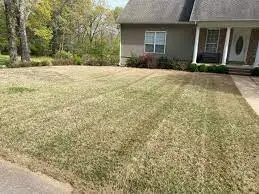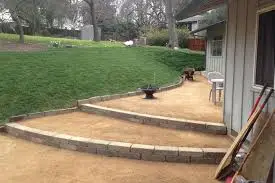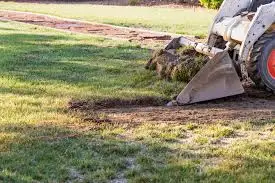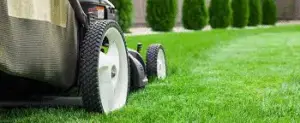Table of Contents
 Grading a yard is usually necessary when a yard consists of various levels. Often times this occurs due to many factors such as soil irregularities or uneven settling. Homeowners can hire contractors to re-grade the yard but these projects can sometimes be costly and may not completely fix the issue.
Grading a yard is usually necessary when a yard consists of various levels. Often times this occurs due to many factors such as soil irregularities or uneven settling. Homeowners can hire contractors to re-grade the yard but these projects can sometimes be costly and may not completely fix the issue.
This is the reason why anyone should keep updating their knowledge and skills with new tools, materials, and techniques for lawn grading.
If you want your lawn to look better than the ones down the street, then this article will help you know the art of grading a yard. Detailed instructions on how to grade a yard by hand are provided in this article.
Let’s talk about how to manually regrade your lawn to fix shallow depressions and deep, prominent slopes.
Measure The Current Grade
One can use a couple of wooden stakes, some twine, a line level, and a tape measure to verify the slope at the house’s foundation, which is where it matters most. Drive one stake near the base and another at about 8 feet. For ease of calculating the slope, Lawn Legion suggests placing the stakes 100 inches apart.
Connect the stake to the string and drive it into the earth close to the house’s foundation. Holding the series taut, you can attach a line level to it and level it by aligning the bubble with the middle of the string.
The second stake needs the thread tied to it. Check how far the line reaches down into the soil next to the second stake. Slope % is calculated by dividing this distance (in inches) by the length (in inches) between stakes and multiplying by 100.
If the string is 100 inches long and the length to the ground is 1.5 inches near the second stake, you would divide 1.5 by 100 to get 0.015, or 1.5 percent. If the calculated percentage falls below the minimum (as in the example), some dirt will need to be removed to bring the grade up to par; if it rises over the maximum, some ground will need to be added.
Poor drainage can also damage walkways and driveways, so taking slope measurements at multiple locations around the foundation are essential.
While you’re working on it, see if there are any bumps or craters that require filling in. You may use a landscaping rake to deal with tiny depressions, but any recessions deeper than an inch will likely need to have dirt added to them.
Recommended Tools
These are the bare necessities for a grass regrade, in my opinion:
- Hardened Steel Pickax
- Spade
- A Shovel with a Flat Head
- Wheelbarrow
- Topping soil for backfilling
- Grass seed and seed mulch
- Use a hose to soak the fresh planting.
You might not need all of these items for a little task, while for a larger one, you might wish to buy extra tools or rent equipment.
An Easy Process For Grading Your Yard
You’ve finally reached the point where you feel comfortable grading your scenery. Ensure you get the best results possible by following these eight steps for levelling a yard.
Concerning Future Obstacles and Preparation

Ensure there are no underlying pipes in the yard leading to the house before you begin grading the area. Always thoroughly search before digging, as some pipelines may be a few inches underground. If you want to have windows in your basement, you’ll need to drill window wells. Window wells should never have soil placed over them.
Finding Your Slope
Learn the direction of the yard’s slope as you stroll around it. Then, connect the two extremes by stringing a level along a taut line. Find the pitch by measuring the distance from the ground at your lowest point up the string.
Get A Truckload Of Soil
Delivery is the most convenient option. Whatever you could require, Bray Topsoil and Gravel will bring it straight to your door!
Locate The Yard’s High And Low Points
Using spray paint can designate the yard’s highest and lowest spots. Water will first begin to drain from higher elevations. The weakest areas will be flooded first. You don’t want familiar places that can’t keep the water moving unless you intentionally funnel the water to a particular site. Just throw some dirt from a wheelbarrow onto the lowest locations to make them taller. To divert water from your house, you should raise the earth surrounding it higher than the slope measurement you took.
Even Out The Ground

The rake’s handle can serve as a lever. Start at the highest place to clear the dirt away from the house and work your way down.
Fill The spots
After the dirt has been levelled, you can use a piece of plywood to press down on it. Fill the space evenly and compact the plywood by jumping and walking heavily on it. If the dirt settles, it will prevent water from draining properly, leading to soggy spots.
Sod New Ground

New grass can be planted once the yard has been leveled and the dirt has been stamped uniformly. Distribute seeds throughout the newly leveled soil. The sources should be churned and dispersed gently with a rake. The roots shouldn’t be buried too deeply, but they should be out of reach of any birds that might find them tasty. It’s okay if some seeds stay on the soil’s surface for the time being.
Wet The Ground Down
Water the seeds with a hose. Using hay or grass clippings as a mulch will help keep the moist soil while concealing your seeds.
Apply More Water To The Lawn
The grass will have risen over the hay within a week of daily watering.
Find The Best Ingredients
Good soil you can quickly disperse is like a secret ingredient in a restaurant dish; it’s essential to the final product, lush grass.
Tips To Keep In Mind While Grading Your Yard

Remember these guidelines for optimal outcomes:
- Yards are easier to level when it’s dry out. Rainy seasons pose a higher risk of soil erosion. Therefore it’s best to avoid doing this kind of work then.
- Backfilling the foundation correctly is crucial. The chance of termites entering a home increases if the soil is too close to the cladding.
- You can recycle grass cuttings in the grading process.
Conclusion
It is concluded that grading your yard is crucial to prevent long-term damage and expensive repairs to your home and landscape. The homeowner can complete the eight-step process presented in the article for grading a yard if the problem is not too severe.
Commercial-grade equipment and an expert’s eye for problem detection may be necessary for your landscape grading.
